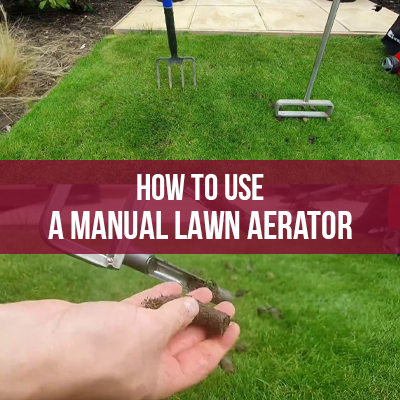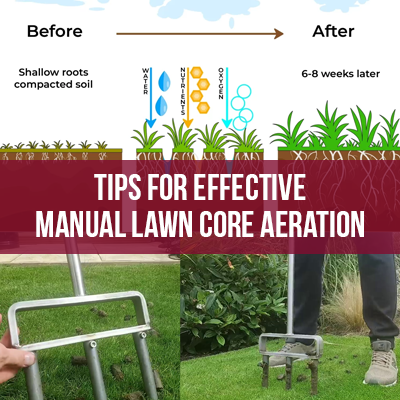
A manual lawn core aerator, simply push the machine over the lawn, allowing the hollow tines to penetrate the soil and extract cores of grass and dirt. This process helps to relieve soil compaction and allows for better air and water circulation in the lawn.
A healthy and lush lawn is a pride for any homeowner. However, over time, soil compaction can occur which limits the grass’s access to essential nutrients and water. This is where a manual lawn core aerator comes in. Using this simple yet effective tool can promote better growth and greener grass.
We will discuss how to use a manual lawn core aerator to achieve a healthy and vibrant lawn. So, let’s dive in and explore the step-by-step process for using a manual lawn core aerator.
Benefits Of Using A Manual Lawn Core Aerator
A manual lawn core aerator offers several benefits for your lawn. Firstly, it helps to increase water and nutrient absorption. By creating small holes in the soil, the aerator allows water and nutrients to penetrate deeper into the roots, promoting healthier growth. This can lead to a lusher and greener lawn.
Another advantage is the reduction of soil compaction. Over time, the soil can become compacted, making it difficult for the roots to receive the necessary air and nutrients. By aerating the lawn, you break up the compacted soil and create space for root expansion, resulting in improved overall health.
Manual lawn core aerator enhances oxygen circulation to the roots, which is essential for their health and vitality. Oxygen is necessary for the root system to perform vital processes, such as nutrient uptake and energy production. By allowing more oxygen to reach the roots, you promote stronger and more resilient grass.
Step-By-Step Process Of Using A Manual Lawn Core Aerator
Selecting the right time for aeration is crucial for optimal results. Autumn or spring, when the grass is actively growing, are the best times. Start by preparing the lawn, ensuring it is clear of debris and mowed to the correct height. Adjust the depth and width of the tines on the aerator based on the condition of your lawn. Aerate the lawn in a systematic pattern, covering the entire area without overlap. Pay extra attention to difficult areas or obstacles, such as tree roots or utility lines, ensuring the aerator’s tines penetrate the soil effectively. Once aerated, it’s important to provide post-aeration care and maintenance. Apply fertilizer, overseed if necessary, and water appropriately to promote healthy growth. Regularly monitor the lawn for any signs of stress and address them promptly.
| Selecting the right time for aeration |
| Preparing the lawn for aeration |
| Adjusting the depth and width of the tines |
| Aerating the lawn in a systematic pattern |
| Handling difficult areas or obstacles |
| Post-aeration care and maintenance tips |
Tips For Effective Manual Lawn Core Aeration

Identifying problem areas for targeted aeration: Before using a manual lawn core aerator, evaluate your yard to identify problem areas that require extra attention. Look for compacted soil, patchy grass, or areas where water puddles.
Understanding the ideal soil conditions for aeration: Aeration works best when the soil is moist but not overly wet. Water your lawn a day or two before aerating to ensure the soil is adequately hydrated. This will make it easier for the aerator to penetrate the ground and extract the cores.
Properly maintaining and cleaning the aerator: Regularly clean and maintain your manual lawn core aerator to ensure optimal performance. Remove any debris or soil buildup after each use. Lubricate moving parts to prevent rust and ensure smooth operation.
Using the right technique for efficient aeration: Start by operating the aerator in a straight line, covering the entire lawn systematically. Overlap each pass slightly to ensure no areas are missed. Apply gentle downward pressure to allow the aerator tines to penetrate the soil deeply, but avoid excessive force.
Maximizing the benefits of aeration through overseeding and fertilization: After aerating, take advantage of the improved soil conditions by overseeding your lawn. The holes created by the aerator provide an excellent environment for new grass seeds to germinate. Additionally, apply a high-quality fertilizer to promote healthy growth and replenish essential nutrients.
Troubleshooting Common Issues With Manual Lawn Core Aeration
Excessive soil plugs or cores can be a common issue when using a manual lawn core aerator. To address this problem, ensure that the soil is not too dry or compacted, as this can lead to larger and more stubborn plugs. Watering the lawn beforehand can help soften the soil, making it easier for the aerator to penetrate.
Uneven or patchy aeration can be frustrating, but there are ways to overcome this challenge. One approach is to make sure you overlap each pass with the aerator to ensure even coverage. Another option is to vary the direction of the aerator with each pass, creating a crosshatch pattern that helps distribute the cores more evenly.
Accessing hard-to-reach areas can be tricky, but there are strategies to make it easier. Consider using a smaller or handheld aerator for tight spots or using a hand trowel to manually aerate these areas. Additionally, removing any obstacles such as rocks or debris can facilitate access to hard-to-reach spots.
Final Thoughts On Manual Lawn Core Aeration
Regular aeration is crucial for maintaining a healthy lawn. By allowing air, water, and nutrients to reach the grassroots, it stimulates growth and strengthens the overall root system. When it comes to aerating your lawn, manual lawn core aerators offer several benefits when compared to other methods. They are affordable, don’t require power or fuel, and provide a more natural and gentle aeration approach.
Here are a few tips for incorporating aeration into your lawn care routine:
- Timing: Aerating during the growing season when your lawn can quickly recover is recommended.
- Moisture: Ensure the soil is moist but not overly saturated before aeration.
- Frequency: Aim to aerate once or twice a year for optimal results.
- Keep the Cores: Leave the soil cores on the lawn as they break down and provide additional nutrients.
- Overseeding: Combine aeration with overseeding to enhance the growth of new grass.
- Maintenance: Follow a regular lawn care routine, including mowing, watering, and fertilizing, to maximize the benefits of aeration.
Incorporating manual lawn core aeration into your lawn care regimen will certainly contribute to a vibrant and healthy lawn.
Frequently Asked Questions For How To Use A Manual Lawn Core Aerator
How Does A Manual Lawn Core Aerator Work?
A manual lawn core aerator works by inserting small hollow tubes into the soil to remove plugs of soil. This helps to improve air, water, and nutrient circulation in the lawn, allowing the roots to grow deeper and making it healthier.
Why Should I Use A Manual Lawn Core Aerator?
Using a manual lawn core aerator helps to alleviate compaction in the soil, which can prevent the lawn from thriving. It improves the overall health of the lawn by increasing oxygen and nutrient flow to the roots, resulting in a greener and more lush lawn.
When Is The Best Time To Use A Manual Lawn Core Aerator?
Best time to use a manual lawn core aerator is during the growing season, when the grass is actively growing. Typically, this is in the spring or fall when the soil is moist and not too dry. Avoid aerating in extreme heat or cold temperatures.
How Often Should I Use A Manual Lawn Core Aerator?
Frequency of using a manual lawn core aerator depends on the condition of your lawn and soil. As a general guideline, it is recommended to aerate once or twice a year for moderate wear lawns, while heavily used lawns may need more frequent aeration.
Conclusion
A manual lawn core aerator can greatly improve the health and appearance of your lawn. By creating small holes in the soil, it allows air, water, and nutrients to reach the roots, promoting strong, vibrant growth. Regularly using a manual aerator can help prevent soil compaction and encourage a lush, green lawn.

1 thought on “How to Use a Manual Lawn Core Aerator”